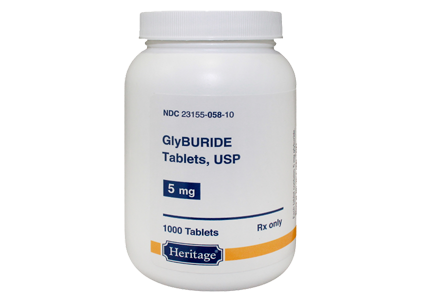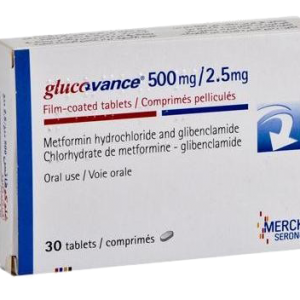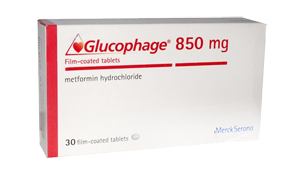What is glyburide?
Glyburide is an oral diabetes medicine that helps control blood sugar levels.
Glyburide is used to treat type 2 diabetes.
This medicine is not for treating type 1 diabetes.
Glyburide may also be used for purposes not listed in this medication guide.
Important information
You should not use glyburide if you are being treated with bosentan (Tracleer), if you have type 1 diabetes, or if you are in a state of diabetic ketoacidosis (call your doctor for treatment with insulin).
Before taking glyburide, tell your doctor if you are allergic to sulfa drugs, if you have been using insulin or chlorpropamide (Diabinese), or if you have hemolytic anemia (a lack of red blood cells), an enzyme deficiency (G6PD), a nerve disorder, liver disease, or kidney disease.
Take care not to let your blood sugar get too low. Low blood sugar (hypoglycemia) can occur if you skip a meal, exercise too long, drink alcohol, or are under stress. Symptoms include headache, hunger, weakness, sweating, tremor, irritability, or trouble concentrating. Carry hard candy or glucose tablets with you in case you have low blood sugar. Other sugar sources include orange juice and milk. Be sure your family and close friends know how to help you in an emergency.
Before taking this medicine
You should not use this medicine if you are allergic to glyburide, or:
if you are being treated with bosentan (Tracleer);
if you have type 1 diabetes; or
if you are in a state of diabetic ketoacidosis (call your doctor for treatment with insulin).
To make sure glyburide is safe for you, tell your doctor if you have:
hemolytic anemia (a lack of red blood cells);
an enzyme deficiency called glucose-6-phosphate dehydrogenase deficiency (G6PD);
a nerve disorder affecting bodily functions;
liver or kidney disease;
if you have taken chlorpropamide in the past 2 weeks;
if you are allergic to sulfa drugs; or
if you have been using insulin or taking chlorpropamide (Diabinese).
Certain oral diabetes medications may increase your risk of serious heart problems. However, not treating your diabetes can damage your heart and other organs. Talk to your doctor about the risks and benefits of taking glyburide.
It is not known whether glyburide will harm an unborn baby. Tell your doctor if you are pregnant or plan to become pregnant while using this medicine. Your doctor may want you to use insulin during pregnancy.
It is not known whether glyburide passes into breast milk or if it could harm a nursing baby. You should not breast-feed while using this medicine.
How should I take glyburide?
Take glyburide exactly as prescribed by your doctor. Follow all directions on your prescription label. Your doctor may occasionally change your dose to make sure you get the best results. Do not take this medicine in larger or smaller amounts or for longer than recommended.
Take glyburide with your first meal of the day, unless your doctor tells you otherwise.
Your blood sugar will need to be checked often, and you may need other blood tests at your doctor’s office.
Low blood sugar (hypoglycemia) can happen to everyone who has diabetes. Symptoms include headache, hunger, sweating, confusion, irritability, dizziness, or feeling shaky. Always keep a source of sugar with you in case you have low blood sugar. Sugar sources include fruit juice, hard candy, crackers, raisins, and non-diet soda. Be sure your family and close friends know how to help you in an emergency.
If you have severe hypoglycemia and cannot eat or drink, use a glucagon injection. Your doctor can prescribe a glucagon emergency injection kit and tell you how to use it.
Older adults may be more likely to have low blood sugar while taking glyburide.
Also watch for signs of high blood sugar (hyperglycemia) such as increased thirst, increased urination, hunger, dry mouth, fruity breath odor, drowsiness, dry skin, blurred vision, and weight loss.
Check your blood sugar carefully during times of stress, travel, illness, surgery or medical emergency, vigorous exercise, or if you drink alcohol or skip meals. These things can affect your glucose levels and your dose needs may also change. Do not change your medication dose or schedule without your doctor’s advice.
Also check your blood sugar levels very closely during pregnancy.
If your doctor changes your brand, strength, or type of glyburide, your dosage needs may change. Ask your pharmacist if you have any questions about the new kind of glyburide you receive at the pharmacy.
Store at room temperature away from moisture and heat. Keep the bottle tightly closed when not in use.
What happens if I miss a dose?
Take the missed dose as soon as you remember. Skip the missed dose if it is almost time for your next scheduled dose. Do not take extra medicine to make up the missed dose.
What happens if I overdose?
Seek emergency medical attention. A glyburide overdose can cause life-threatening hypoglycemia.
Symptoms of severe hypoglycemia include extreme weakness, confusion, tremors, sweating, fast heart rate, trouble speaking, nausea, vomiting, rapid breathing, fainting, and seizure (convulsions).
What should I avoid while taking glyburide?
If you also take colesevelam, avoid taking it within 4 hours after you take glyburide.
Avoid drinking alcohol. It lowers blood sugar and may interfere with your diabetes treatment.
Avoid exposure to sunlight or tanning beds. Glyburide can make you sunburn more easily. Wear protective clothing and use sunscreen (SPF 30 or higher) when you are outdoors.
Glyburide side effects
Get emergency medical help if you have any signs of an allergic reaction to glyburide: hives; difficult breathing; swelling of your face, lips, tongue, or throat.
Stop using this medicine and call your doctor at once if you have:
easy bruising or bleeding (nosebleeds, bleeding gums);
sudden weakness or ill feeling, fever, chills, sore throat, mouth sores, red or swollen gums, trouble swallowing;
liver problems–nausea, upper stomach pain, itching, tired feeling, loss of appetite, dark urine, clay-colored stools, jaundice (yellowing of the skin or eyes); or
low levels of sodium in the body–headache, confusion, slurred speech, severe weakness, vomiting, loss of coordination, feeling unsteady.
Common glyburide side effects may include:
nausea, upset stomach, heartburn, feeling full;
muscle or joint pain;
blurred vision; or
mild rash or skin redness.
This is not a complete list of side effects and others may occur. Call your doctor for medical advice about side effects.
Glyburide dosing information
Usual Adult Dose for Diabetes Type 2:
Initial dose: 2.5 mg (standard) or 1.5 mg (micronized) orally once a day in the morning with breakfast.
Maintenance dose: 1.25 to 20 mg (standard) or 0.75 to 12 mg (micronized) orally in 1 or 2 divided doses.
Maximum dose: 20 mg/day (standard) or 12 mg/day (micronized).
Usual Geriatric Dose for Diabetes Type 2:
Initial dose: 1.25 to 2.5 mg (standard) orally or 0.75 to 1.5 mg (micronized) orally once a day.
What other drugs will affect glyburide?
You may be more likely to have hypoglycemia (low blood sugar) if you take glyburide with other drugs that can lower blood sugar, such as:
exenatide (Byetta);
probenecid (Benemid);
aspirin or other salicylates (including Pepto Bismol);
a blood thinner (warfarin, Coumadin, Jantoven);
sulfa drugs (Bactrim, SMZ-TMP, SMX-TMP, and others);
a monoamine oxidase inhibitor (MAOI); or
insulin or other oral diabetes medications.
This list is not complete, and many other medicines can increase or decrease the effects of glyburide on lowering your blood sugar. This includes prescription and over-the-counter medicines, vitamins, and herbal products. Tell your doctor about all medicines you use, and those you start or stop using during your treatment with glyburide. Not all possible interactions are listed in this medication guide.




